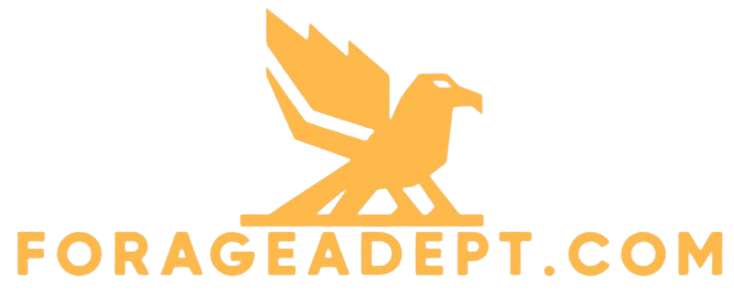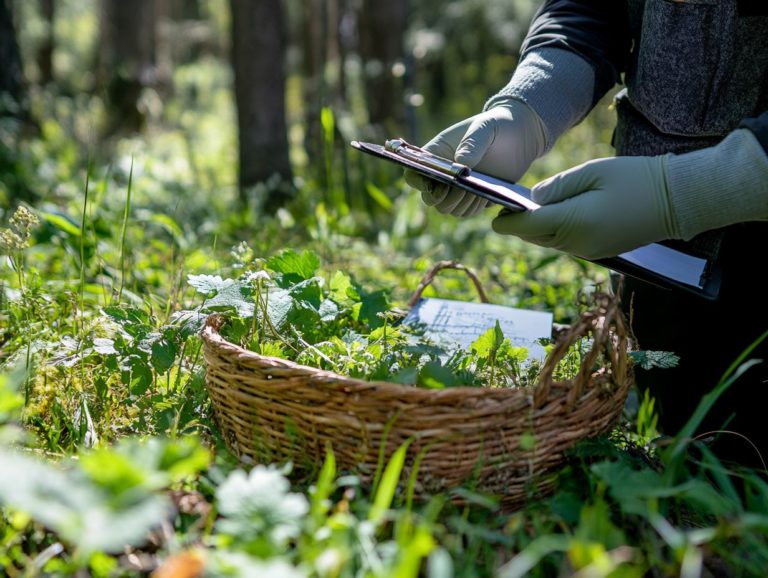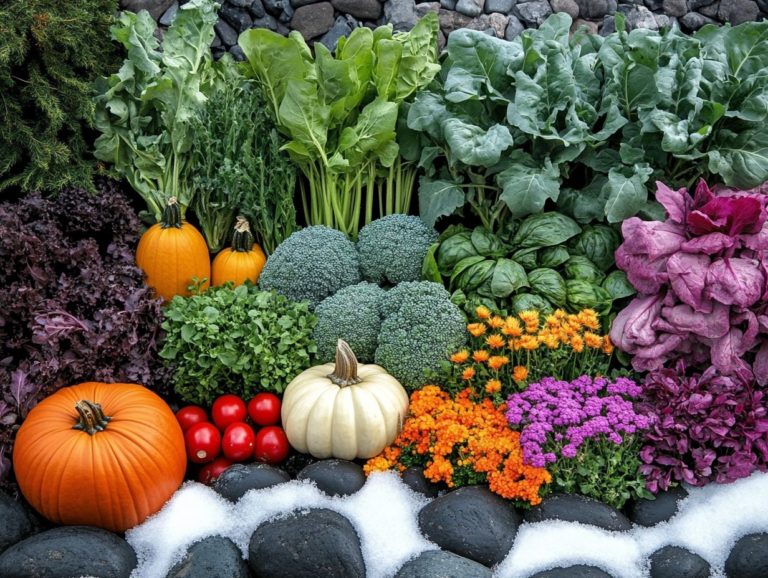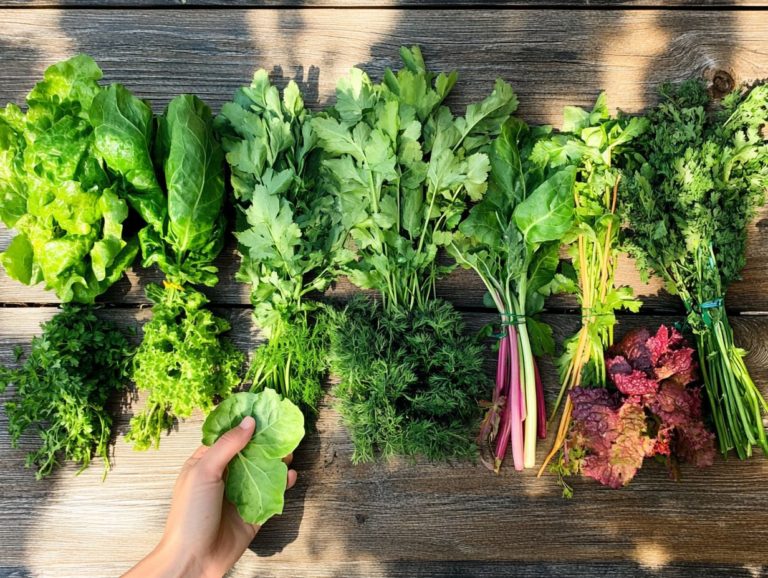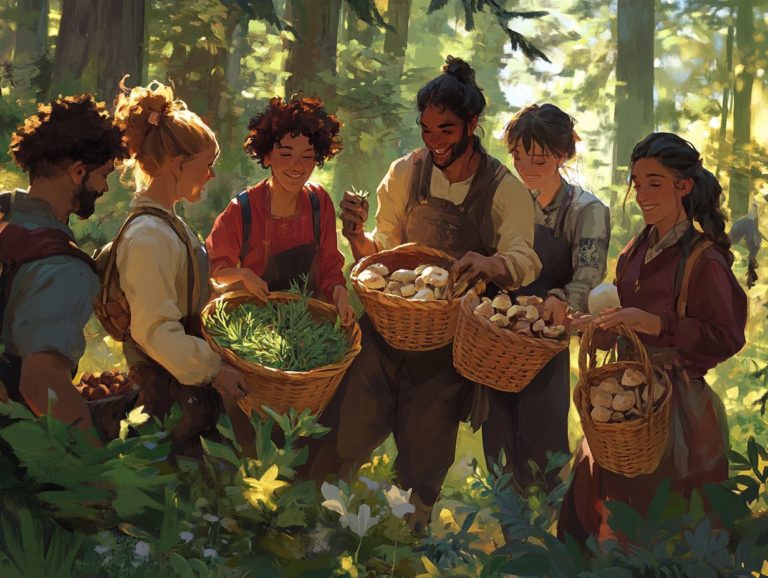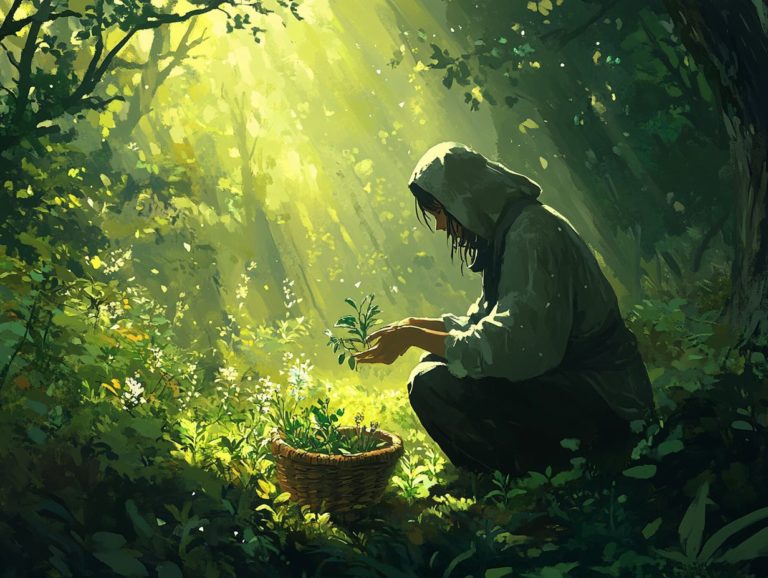Creating a Foraging Checklist for Safe Harvesting
Foraging presents you with a remarkable opportunity to connect with nature while uncovering the rich bounty that surrounds you, including wild food and edible plants.
Whether you’re just starting out or consider yourself a seasoned forager, grasping the nuances of this practice is crucial for safe and sustainable harvesting.
This guide will walk you through the essentials, from identifying edible plants and understanding their seasonal availability to mastering the proper techniques for gathering and cooking.
You’ll also explore vital safety precautions, the ethics of foraging, and the numerous benefits of embracing this fulfilling endeavor, fostering community engagement and sustainable practices.
Are you ready to dive into nature’s pantry today?
Contents
- Key Takeaways:
- 1. Understanding Foraging Basics
- 2. Identifying Edible Plants
- 3. Understanding Seasonal Availability
- 4. Knowing Your Location and Local Regulations
- 5. Proper Tools and Equipment for Foraging
- 6. Safety Precautions to Take
- 7. Identifying Poisonous Plants
- 8. Proper Harvesting Techniques
- 9. Sustainable Foraging Practices
- 10. Cleaning and Storing Your Harvest
- 11. Cooking and Preparing Foraged Foods
- 12. Foraging with Children
- 13. Foraging Ethics and Respect for Nature
- 14. Common Mistakes to Avoid
- 15. Benefits of Foraging for Your Health and the Environment
- Frequently Asked Questions
Key Takeaways:
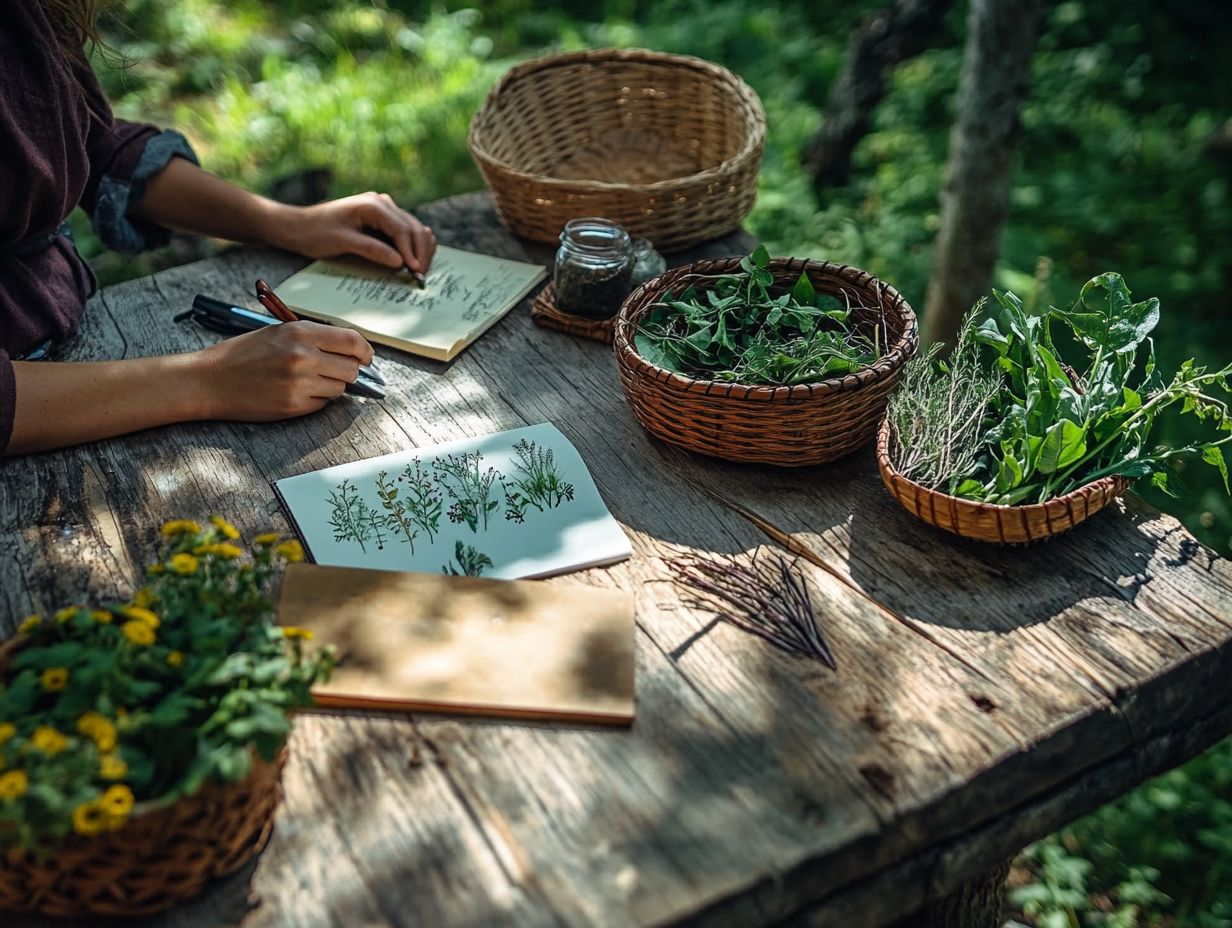
- Be familiar with foraging basics, including identifying edible plants and understanding seasonal availability.
- Follow local rules, use the right tools, and prioritize your safety while foraging.
- Practice sustainable foraging by respecting nature, properly gathering, and cleaning and storing your harvest.
1. Understanding Foraging Basics
Foraging is an ancient practice that offers you a unique opportunity to connect with nature and discover wild foods.
Learning to identify edible plants like dandelions, blackberries, and morels enhances your outdoor adventures. This activity promotes community engagement through shared experiences and local knowledge, making learning to forage all the more rewarding.
This time-honored tradition has been around for centuries, providing sustenance long before agriculture took center stage.
As you venture into the wild, you might encounter a diverse array of edible plants such as stinging nettles, wild garlic, and elderflowers, as well as wild mushrooms like morels and Chicken of the Woods, all brimming with essential nutrients.
Learning to forage can elevate your meals with fresh, vibrant ingredients while deepening your appreciation for the environment. Engaging with local foraging groups or workshops will expand your knowledge, helping you confidently identify safe and nutritious plants while fostering social connections.
Numerous online resources, including foraging apps and community forums, stand ready to assist you on this rewarding journey, making it easier than ever to dive into the world of foraging.
2. Identifying Edible Plants
Identifying edible plants is an essential skill for you as a forager. Recognizing wild plants like chickweed, nasturtium, and rose hips allows you to safely savor the diverse wild foods in your area.
To hone this skill, focus on key physical characteristics such as:
- Leaf shape
- Flower color
- Growth habits
These details can significantly help you differentiate between safe and harmful species. For instance, while wild garlic and lily of the valley might inhabit similar spaces, their features are distinctly different.
Taking herbalism courses, which are classes that teach you about plants and their uses, can provide you with invaluable insights into plant properties, including the nutritional benefits of edible species and the preparation of wild food.
With the right guidance, you can master the identification of popular foraging species like dandelions and wild blueberries, enriching both your culinary skills and your appreciation for nature’s bounty.
Utilizing field guides, mobile apps, and regional guides can also be incredibly helpful in making your plant identification process more efficient and effective.
We encourage you to share your foraging experiences or recipes to foster community interaction.
3. Understanding Seasonal Availability
Understanding the seasonal availability of wild food is crucial for any forager. Different edible plants and mushrooms flourish at specific times of the year, impacting both the variety and nutritional benefits of what you can forage.
Take early spring, for example. It gifts you with a bounty of tender greens like ramps and dandelion leaves. These are perfect for harvesting before other plants have a chance to make their grand entrance.
As spring moves along, you ll find morels emerging those delightful mushrooms are a true delicacy, peaking between late April and early May. Summer arrives with vibrant berries, such as blackberries and blueberries, not to mention the unmistakable Chicken of the Woods mushroom, which tends to grace your path during warmer months.
When fall rolls around, it s all about hearty nuts and mushrooms like chanterelles. Meanwhile, winter foraging reveals wild greens that brave the chill. Each season offers unique opportunities, reminding you of the importance of adapting your practices and expanding your knowledge.
This approach ensures your foraging experience remains sustainable and rewarding throughout the year.
4. Knowing Your Location and Local Regulations
Understanding your location and the local regulations surrounding foraging is crucial for sustainable practices. This helps you respect nature while using regional guides to identify effective gathering techniques.
Not only does this protect ecosystems, but it also fosters harmony between foragers and local communities. It’s essential to grasp local foraging laws, as various restrictions may apply depending on the area, including national parks, protected lands, and private properties. This is especially important when foraging for mushrooms like hemlock or death cap.
To effectively research these regulations, consult local government websites, join community forums, or connect with experienced foragers in your area. Resources like field guides, botanical organizations, and safety guidelines can also offer valuable insights for responsible and ethical foraging practices.
5. Proper Tools and Equipment for Foraging
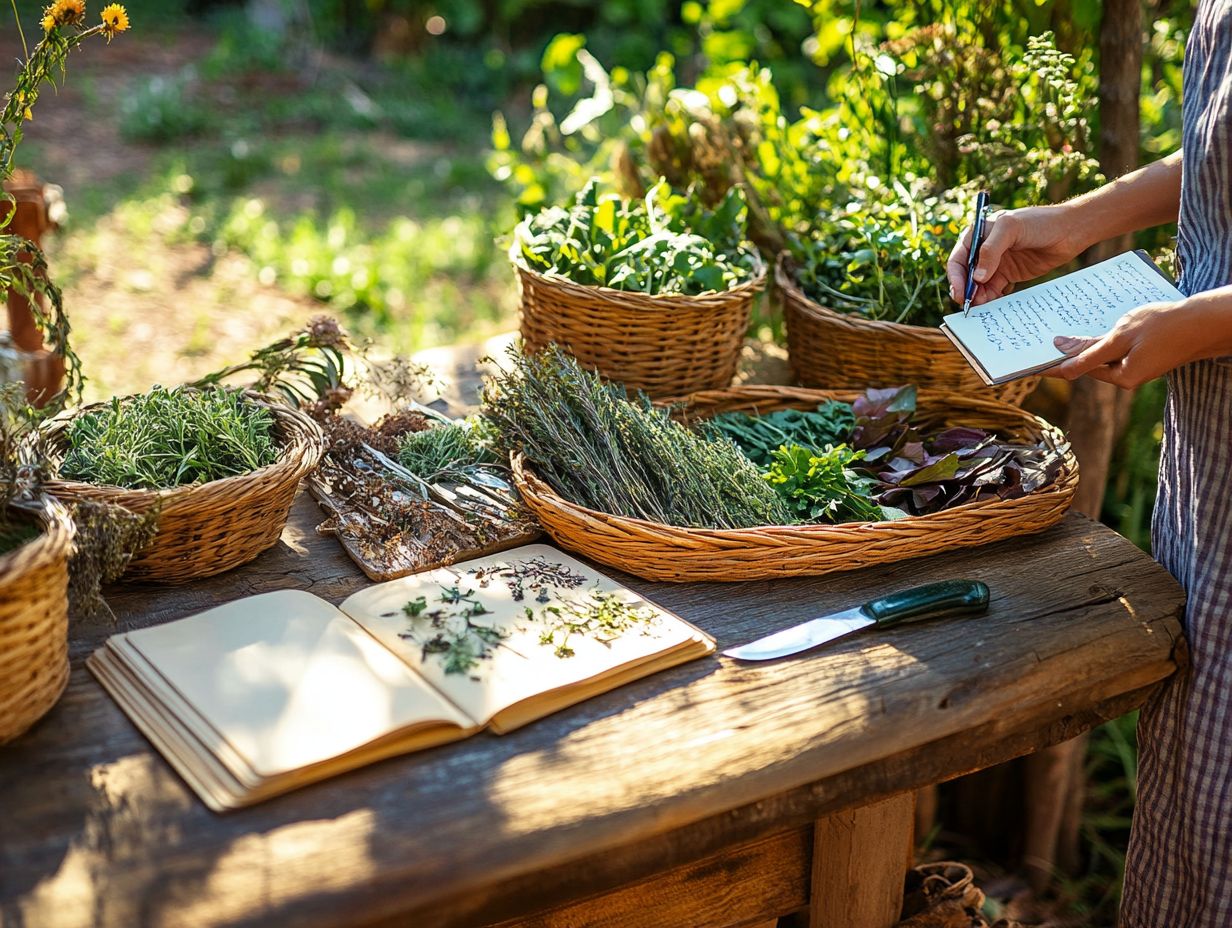
Equipping yourself with the right tools and equipment is vital for successful foraging. With the appropriate gear, you enhance your ability to gather wild food effectively while honing essential skills that contribute to hiking safety.
One of the most important tools you ll need is a sturdy basket or bag for collecting your finds. This not only provides ample space but also allows for ventilation, keeping fragile items fresh.
A reliable knife is another must-have, enabling you to cut plants and fruits cleanly without causing unnecessary damage. Don’t underestimate the value of carrying field guides; they can significantly enhance your foraging experience.
These guides help you identify edible specimens and distinguish them from their toxic counterparts. For added safety, consider following foraging for edible plants: safety tips. Together, these tools empower you to navigate the wild with confidence and ease, transforming your foraging adventures into both efficient and enjoyable pursuits.
6. Safety Precautions to Take
Implementing safety guidelines for harvesting wild edibles while foraging is essential for your protection and that of others. Stay excited about foraging while keeping safety in mind!
Preparing in advance can greatly enhance your foraging safety. Familiarize yourself with the local flora and fauna, verify the edibility of plants, and understand when is the right time for harvesting by following safety tips for foraging.
Equipping yourself with the right safety gear like sturdy gloves and reliable footwear will help mitigate the risks of navigating various terrains. Be mindful of your environment; checking for potential hazards such as poison ivy, oleander, or unstable ground can effectively prevent accidents.
Engaging with the community is vital in fostering a culture of safety. By sharing your personal experiences and safety tips, you can empower new foragers to explore with confidence while respecting the beauty of nature.
7. Identifying Poisonous Plants
Identifying poisonous plants is an essential skill for anyone venturing into foraging. Understanding the distinctions between edible species and dangerous ones, like hemlock or death cap mushrooms, is crucial to prevent harmful encounters.
This knowledge means recognizing many plants, not just a handful of hazardous types. It means knowing well the local flora. Familiarize yourself with the plants in your area, paying close attention to specific characteristics such as leaf shape, flower color, and growth habits.
Using tools like the universal edibility test, which helps determine if a plant is safe to eat, adds an extra layer of safety. However, remember that this test isn t infallible, highlighting the need to follow established safety guidelines.
Being well-prepared and educated can significantly enhance your foraging experience, ensuring it is both safe and rewarding.
8. Proper Harvesting Techniques
Using proper harvesting techniques is essential for sustainable foraging. This allows you to gather wild food, including wild mushrooms, while protecting the plant community and promoting responsible practices.
Different harvesting methods can impact local ecosystems. For example, selective harvesting, which means picking only certain parts of a plant, ensures some plants remain unharmed, encouraging their natural regeneration.
By using the right tools, like handheld sickles or pruners, you can minimize damage to the surrounding environment, reducing disruption to delicate habitats.
Engaging with your community to share experiences and best practices cultivates a culture of respect for nature. Emphasizing the importance of leaving enough plants intact helps preserve these resources for future generations and maintains the delicate balance of ecosystems.
9. Sustainable Foraging Practices
Sustainable foraging practices are crucial for nurturing ecosystems while allowing you to enjoy the nutritional benefits of wild food. This approach fosters community engagement that honors nature.
Prioritizing techniques that minimize ecological disruption helps ensure that plant and animal populations thrive. For instance, using the ‘one in, one out’ rule encourages you to take only what you need while supporting local biodiversity through seed dispersal or planting.
Organizing community workshops centered on ethical foraging guidelines empowers others to appreciate and safeguard local ecosystems. These initiatives cultivate a shared understanding of conservation s importance and foster collective responsibility for maintaining nature’s balance.
10. Cleaning and Storing Your Harvest
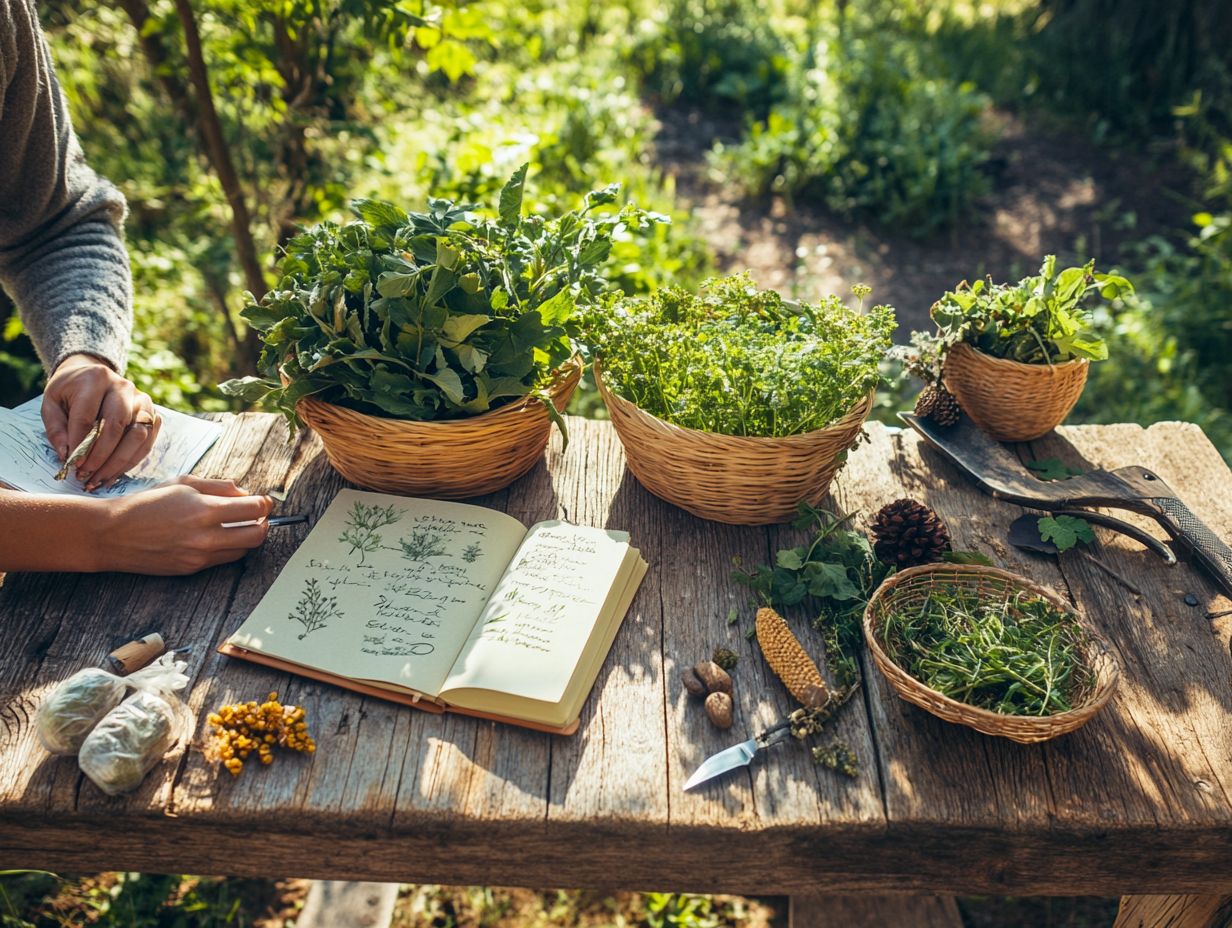
Cleaning and storing your harvest is an essential step in foraging. Proper techniques ensure the quality and longevity of your foraged foods, paving the way for delightful cooking experiences.
To start, carefully remove dirt and debris from your gathered items. Gentle rinses work wonders for leafy greens, while a soft brush is perfect for tougher skins. After cleaning, dry them thoroughly to prevent moisture buildup, which can lead to spoilage.
Store your foraged treasures in breathable containers to enhance freshness. Refrigeration or freezing can significantly extend their shelf life.
These practices safeguard the natural flavors and nutrients of your foraged goodies and elevate your culinary techniques. This allows you to create vibrant dishes that celebrate the seasons and deepen your connection to the wild.
11. Cooking and Preparing Foraged Foods
Cooking and preparing foraged foods can be a truly delightful experience. Incorporating wild ingredients into your meals elevates flavor and offers nutritional benefits that support a vibrant lifestyle.
As you delve into the unique textures and tastes of foraged ingredients, you’ll discover an exciting culinary realm. For instance, the earthy umami of wild mushrooms can be beautifully enhanced by saut ing them with garlic and herbs. This results in a side dish that elevates any main course.
On the other hand, the sweet tartness of freshly foraged berries has the power to transform a simple breakfast into a gourmet delight when blended into smoothies or drizzled over yogurt. Each foraged item introduces distinctive flavors and provides an array of vitamins and antioxidants.
Embarking on the journey of exploring wild foods is not just a feast for your palate but also a rewarding adventure for your health.
12. Foraging with Children
Foraging with children offers a delightful blend of fun and education in the great outdoors. It nurtures a love for nature and community engagement while imparting the vital lessons of responsible and safe foraging.
Engaging in this practice can spark curiosity and foster a deep respect for the environment. This allows young ones to truly connect with the natural world around them. To ensure a joyful and safe experience, begin with simple, age-appropriate tasks, like identifying common edible plants or gathering safe herbs right from your backyard.
As they become more confident, your family can venture into local parks or forests together. Emphasizing safety is essential; it is important to teach them to steer clear of poisonous plants and to only consume items they can confidently identify.
Ultimately, introducing wild food exploration at an early age deepens children s understanding of ecosystems and encourages healthy eating habits that can last a lifetime.
13. Foraging Ethics and Respect for Nature
Embrace foraging ethics and respect for nature! These principles guide you to sustainable practices and build a vibrant community around wild food.
By placing the well-being of local ecosystems at the forefront, you help ensure that native plants and wildlife flourish. This ultimately supports the health of the environment as a whole. Approach each foraging adventure with a sense of mindfulness; make sure to leave no trace and minimize any disturbances to the habitats you explore.
Join community discussions about sustainable foraging methods! These conversations not only raise awareness of these vital practices but also provide opportunities to share your own experiences and insights. They educate and inspire a collective responsibility, ensuring that nature’s bounty is preserved for generations to come.
14. Common Mistakes to Avoid
Avoiding common mistakes while foraging is essential for you as a beginner. A lack of knowledge in plant identification and safety guidelines can lead to unpleasant experiences or worse, danger. To enhance your skills, refer to the best local resources for foraging safety.
One of the most frequent pitfalls is misidentifying edible plants, which could result in poisoning or significant discomfort. Invest time in thorough education whether through trusted guidebooks or engaging local workshops.
Don’t neglect safety precautions they can lead to serious consequences. Always be mindful of your surroundings, steering clear of toxic areas and potential allergens. Remember that overharvesting can deplete local ecosystems, negatively impacting not just the plants but also the wildlife that relies on them.
To navigate these challenges adeptly, always carry a reliable reference, forage in moderation, and seek mentorship whenever possible.
15. Benefits of Foraging for Your Health and the Environment
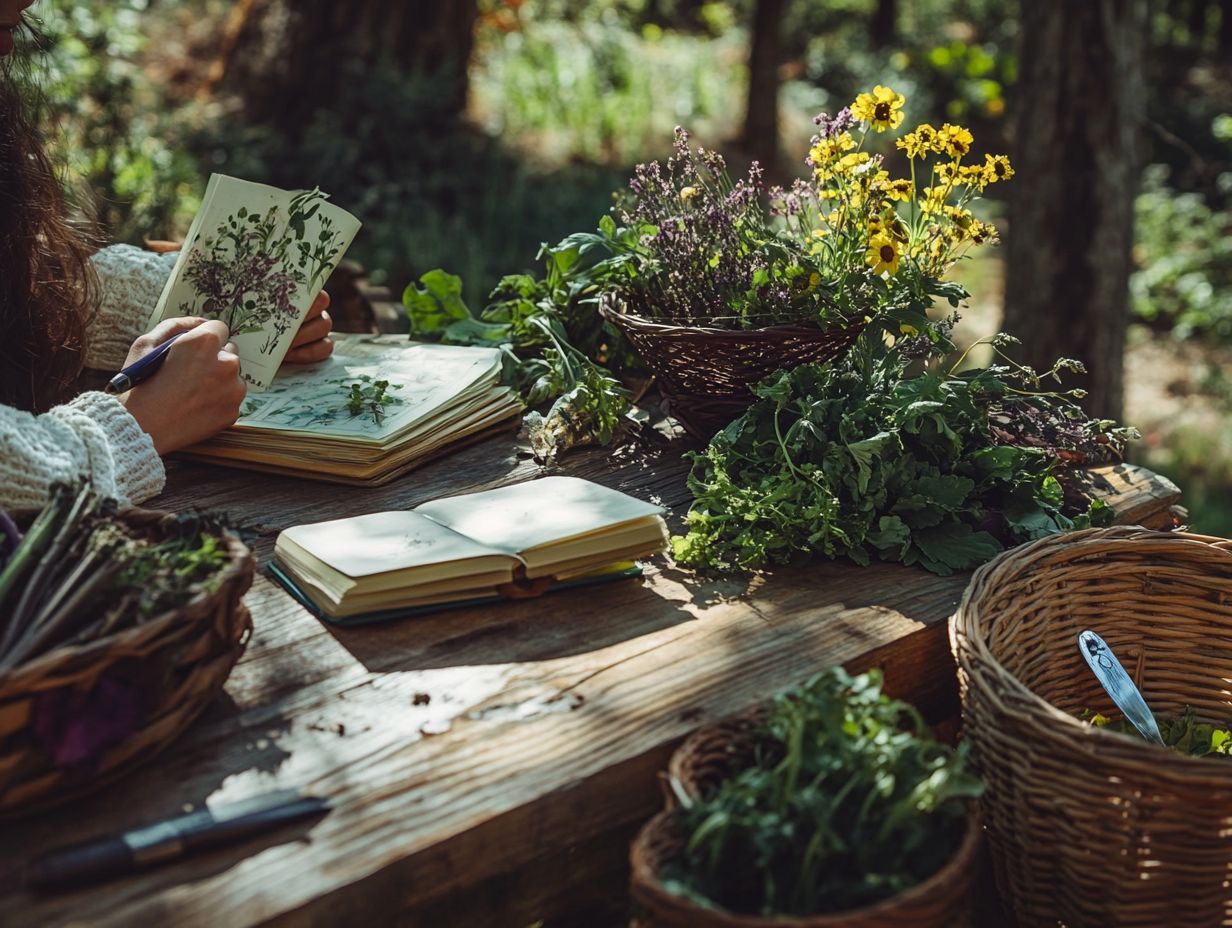
Foraging isn’t just fun; it brings amazing health benefits! The advantages go well beyond personal enjoyment; they provide significant health advantages through the consumption of healthy food choices. This practice also positively impacts the environment and fosters community engagement around shared experiences and knowledge.
By embracing wild edibles, you can enhance your diet with healthy food choices. This introduces greater variety and the potential for health improvements.
Foraging encourages an active lifestyle as you traverse diverse landscapes in search of these natural treasures, deepening your connection to the local ecosystem.
Engaging in this practice opens the door to meaningful conversations and collaborative efforts within your community. You can share your finds, recipes, and knowledge of sustainable harvesting methods, which are ways to gather plants without harming the ecosystem.
This collective enthusiasm not only strengthens bonds among individuals but also instills a shared responsibility for preserving local habitats and biodiversity.
Frequently Asked Questions
What is a foraging checklist and why is it important?
A foraging checklist is a list of items or actions to complete before and during a harvesting trip. It helps ensure safe and responsible foraging practices, guiding you on what to harvest during your adventures.
How do I create a foraging checklist?
Start by researching the local laws and regulations for harvesting in your area. Next, make a list of essential items such as permits, equipment, and safety gear. Finally, include steps for proper identification and harvesting techniques.
What should be included in a foraging checklist?
A foraging checklist should include items such as permits, safety equipment, a first aid kit, proper tools, and storage containers. It should also include steps for identifying and harvesting plants, along with essential foraging safety tips for seasonal gatherers and any necessary precautions or warnings.
Why is it important to follow a foraging checklist?
Following the ultimate checklist for foraging edibles helps ensure a safe and responsible harvesting trip. It keeps you organized and prepared, while also helping you follow proper techniques for identifying and harvesting plants.
Do I need to update my foraging checklist regularly?
Yes, it is important to review and update your foraging checklist regularly. Laws and regulations may change, and your equipment or tools may need to be replaced. Additionally, identifying safe edibles can vary as new plants come into season or become available for harvesting.
Can I use someone else’s foraging checklist?
Avoid using someone else’s foraging checklist without adapting it to your needs. Different foraging trips require specific guidelines based on your location and the plants available, and knowing how to forage edible plants safely is crucial for a successful experience.
